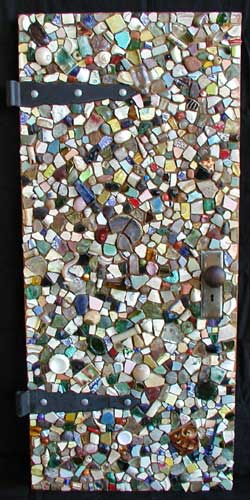
“Mosaic Door” mosaic sculpture. ceramics, glass, porcelain and found objects on small oak door. 50″ x 22″
“Mosaic Door” Contemporary Mosaic Sculpture.
“Mosaic Door” is a “found-object” mosaic. From my experience with the supply business, I see quite a bit of found-object art that is poorly executed. You don’t have to look at too much found-object mosaic before you get a feel for the amount of work and thought and craft that should go into it, even when the pattern is random. When the patience or the craft is missing, usually the work looks sloppy or half-hearted instead of playful. I encourage people to take their time and not try to complete a project in a single afternoon. Instead, take your time and enjoy and learn from what you are doing. The finished product will be done soon enough, and the journey is at least as important as the destination.
The following is an excerpt from my interview with Lisa Graley in The Humanities Education and Research Association’s Interdisciplinary Humanities journal, fall 2003 issue, in which I talk about collecting fossils and arrowheads as a boy, and how this ultimately lead to mosaics:
JOE MOORMAN: … Mosaic-making came about as a culmination of things I’d done my whole life. I’d always dabbled in making things on the side, carving and sculpting with wire. And in spite of growing up in the Mississippi Delta region, I had been a collector of fossils and arrowheads. Most of the state of Mississippi is made of alluvial deposits, but particularly the Delta. It’s flat, full of river-silt mud. You don’t hit gravel till you go down thirty or even 150 feet in some places. It’s deprived of stone just like Mesopotamia, for the same reason. It’s all river mud. So I grew up reading about fossils, but couldn’t look for any because the Delta didn’t have anything, not even rocks. But then there were trips up to hills, where my daddy’s family is from, up in Grenada county. There the hills are actually old gravel bars and sand bars that the river made millions of years ago. I’d go out with my daddy or great uncles and walk the creeks where they cut through the bottoms between the hills. I’d find arrowheads or large quaternary fossils–big teeth and mammoth tusks–from interglacial periods, and there were gravel deposits from eons ago. Every rock was from somewhere else. It might have washed down from the Missouri River or some place as far as Montana. In most any place in Mississippi, except the muddy Delta, you walk across a creek, and you’re liable to find anything from agate to brachiopods—they’re fossils as old as trilobites, extinct, but resemble seashells—just anything, old fossils from before dinosaurs—and then bottles from the 1800’s, pieces of broken china and weathered glass. I collected all that stuff and had it in boxes. Then one of my great-uncles gave me his arrowhead collection before we went back home to the Delta. I remember that as one of the best things anyone ever gave me as a kid. I was literally speechless. Later on, my dad gave me his collection of old antique bottles. And then there were all the spark plugs and deer teeth I found walking down railroad tracks. I never got rid of any of it, even after I grew up. At some point, I just started arranging these things, making mandelas and patterns of it all, and it kind of evolved into mosaics.
LISA GRALEY: Was there ever any hesitation on your part to mix natural with manmade materials? It would seem you’re linking the natural environment with things that pollute it—beach pebbles alongside bottlenecks, for instance.
MOORMAN: When you collect stuff like that, you get things from civilizations before—arrowheads and pottery pieces of the Native Americans, but things even from the recent past, from a few generations back where maybe a house has burned down. Growing up, I never segregated the natural from the manmade. All of these things are artifacts. Mollusks leave their shells behind. Houses burn down and the woods grow back. What we’re left with is melted glass, broken plates. These are artifacts for us. The snail isn’t the shell. That’s just the remnant, a piece of what has been. The manmade artifacts are like that—shells of a life that has been.

